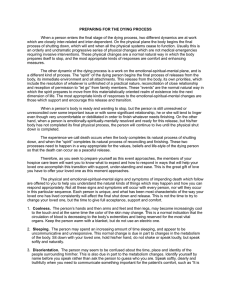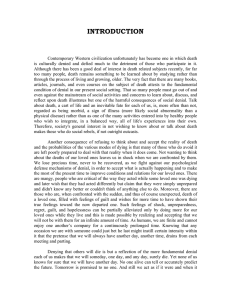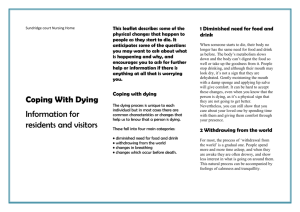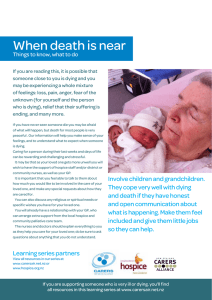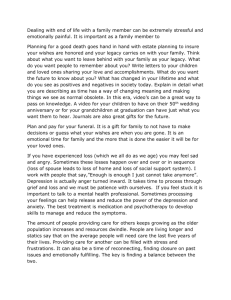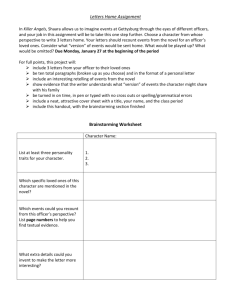When Death Nears... Signs and Symptoms
advertisement
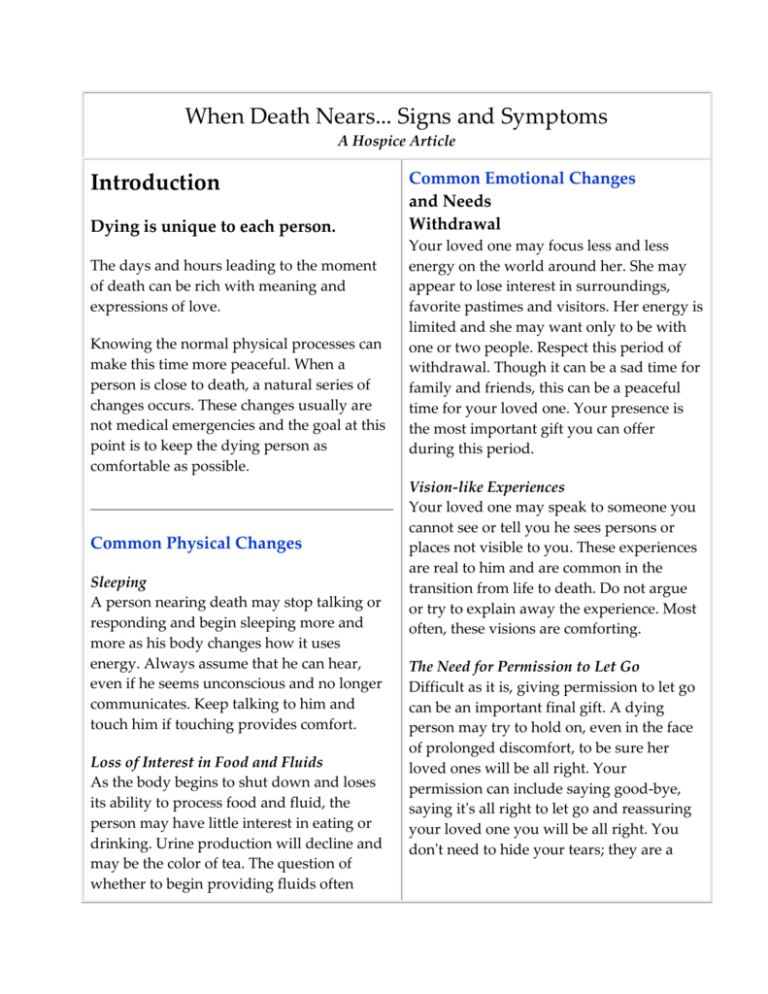
When Death Nears... Signs and Symptoms A Hospice Article Introduction Dying is unique to each person. The days and hours leading to the moment of death can be rich with meaning and expressions of love. Knowing the normal physical processes can make this time more peaceful. When a person is close to death, a natural series of changes occurs. These changes usually are not medical emergencies and the goal at this point is to keep the dying person as comfortable as possible. Common Physical Changes Sleeping A person nearing death may stop talking or responding and begin sleeping more and more as his body changes how it uses energy. Always assume that he can hear, even if he seems unconscious and no longer communicates. Keep talking to him and touch him if touching provides comfort. Loss of Interest in Food and Fluids As the body begins to shut down and loses its ability to process food and fluid, the person may have little interest in eating or drinking. Urine production will decline and may be the color of tea. The question of whether to begin providing fluids often Common Emotional Changes and Needs Withdrawal Your loved one may focus less and less energy on the world around her. She may appear to lose interest in surroundings, favorite pastimes and visitors. Her energy is limited and she may want only to be with one or two people. Respect this period of withdrawal. Though it can be a sad time for family and friends, this can be a peaceful time for your loved one. Your presence is the most important gift you can offer during this period. Vision-like Experiences Your loved one may speak to someone you cannot see or tell you he sees persons or places not visible to you. These experiences are real to him and are common in the transition from life to death. Do not argue or try to explain away the experience. Most often, these visions are comforting. The Need for Permission to Let Go Difficult as it is, giving permission to let go can be an important final gift. A dying person may try to hold on, even in the face of prolonged discomfort, to be sure her loved ones will be all right. Your permission can include saying good-bye, saying it's all right to let go and reassuring your loved one you will be all right. You don't need to hide your tears; they are a arises. If food or fluids are given artificially at this point, the person may feel discomfort. However, she may want small amounts of ice chips or a Popsicle. Proper care of the mouth is particularly important at this time. Coolness The patient's nose, ears, hands, arms, feet and legs may feel increasingly cool to the touch. This is because blood circulation is decreasing. Keep him warm with extra covering, but don't use an electric blanket. He may not be able to sense or tell you if the blanket overheats. Changes in Skin Color The skin, especially on the hands and feet, may look blue and blotchy. This is called mottling and is caused by slow blood circulation. The underside of his body may become darker. You may notice a bluish gray color around the mouth or paleness in the face. Rattling Sounds in the Lungs and Throat Rattling sounds, which can be quite loud, can occur when a person is taking fewer fluids and loses the ability to cough up secretions. This rattling does not signal additional pain or discomfort. Suctioning generally is not recommended, since this increases secretions and discomfort. You can turn your loved one's head or body gently to the side. Keep the mouth moist and clean. Bladder and Bowel Changes The ill person may lose the ability to control urine and stool as the muscles in that area begin to relax. Check with your doctor about natural expression of your love. The Need to Say Good-bye You might wish to call friends and family members who want to share their thoughts and expressions of love with your dying loved one. Good-byes can be as simple as "I love you and I'll miss you." Good-byes can include sharing some beloved memories and saying "Thank you," or making amends with "I'm sorry for whatever difficulties..." Share these important messages, even if the dying person doesn't seem to respond. Remember, hearing is among the last senses to fade. The Need of Friends to Feel Useful Many times, friends may offer to help. These are sincere offers, so if you need some practical help such as picking up a prescription, picking up a relative at the airport or delivering dry cleaning, let friends and family fell useful. They will be grateful to you for letting them help. Choosing the Setting Even during the dying process, a person continues to protect and nurture those he or she loves. For many sick persons, death is a very private act and they will wait for the few brief minutes they can be alone to slip away. Others will wait until they are alone with one or two special persons to let go. Still others will leave amid a circle of loving faces around their bedsides. However death occurs, trust that it was probably they way your loved one chose it to be. whether a catheter is needed. Disposable bed pads or adult Depends also may help. When Death Occurs Disorientation and Restlessness A person nearing death may seem confused about the time or place. She may not recognize familiar faces. She may show restlessness, such as pulling at bedding or clothing. These behaviors occur as a result of less oxygen to the brain, chemical changes in the body and medications. If disorientation occurs, identify yourself by name and speak softly but clearly. Explain the procedures your are doing, such as "We're going to turn you now" or "I'm going to help you take your medicine now." Handholding, quiet music, or reading out loud may be calming. Surge of Energy Occasionally, when someone is close to death, he has a temporary increase in energy and alertness. He may become talkative after a period of disorientation or sleepiness. He may ask for a favorite food after having refused meals and he may ask for visitors after a period of withdrawal. Take advantage of this time; it can be one of special closeness and a chance to express your love and support. Breathing Pattern Changes Breathing patterns often change as the body continues to shut down. You may notice period of rapid, shallow breathing. Or you may see shallow breathing with a space of five to 60 seconds between breaths. This is called Cheyne-Stokes breathing. http://endoflifecare.tripod.com/Caregiving/id89.html Though you have been present during the dying process, the actual moment of death will be powerful. Each person will experience it differently. The signs that death has occurred are No breathing for a prolonged period of time No heartbeat Eyes fixed and slightly open, with enlarged pupils Jaw relaxed, with the mouth slightly open. Whether death occurs at home, a hospital or a nursing home, family and friends may want to sit with the body for a time. There is no need to rush things, and sitting with the body, praying or reminiscing, may be comforting. If death occurs in a facility, the nurses will help with procedures. If it occurs at home under hospice care, the hospice nurse should be called to come and assist. If death occurs at home without hospice, the physician should be notified. In some counties, the police may come to the home. It is important that they know the death was expected. Although this is one of life's most painful experiences, it also can be a rich time of expressions of love and gratitude.


